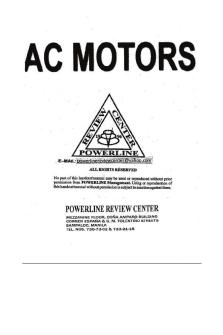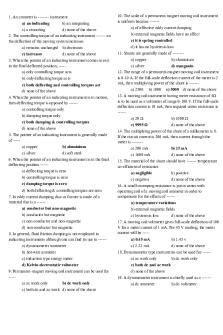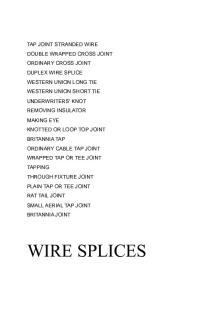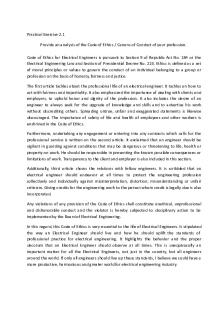Electrical Engineering Hambley 7th Ed Chapter 14 Solutions PDF

| Title | Electrical Engineering Hambley 7th Ed Chapter 14 Solutions |
|---|---|
| Course | Electric Machines and Actuators |
| Institution | Ryerson University |
| Pages | 10 |
| File Size | 264 KB |
| File Type | |
| Total Downloads | 69 |
| Total Views | 123 |
Summary
Electrical Engineering Hambley 7th Ed Chapter 14 Solutions...
Description
CHAPTER 14 Exercises E14.1
If one grasps the wire with the right hand and with the thumb pointing north, the fingers point west under the wire and curl around to point east above the wire.
E14.2
If one places the fingers of the right hand on the periphery of the clock pointing clockwise, the thumb points into the clock face.
E14.3
f qu B ( 1.602 10 19 )10 5 ux uy 1. 602 1014 uz in which ux, u y, and uz are unit vectors along the respective axes.
E14.4
f iB sin(θ) 10(1)0.5 sin(90 ) 5 N
E14.5
(a) φ BA Bπ r 2 0.5π (0. 05)2 3. 927 mWb λ Nφ 39.27 mWb turns (b) e
39 .27 10 3 dλ 39.27 V 10 3 dt
More information would be needed to determine the polarity of the voltage by use of Lenz’s law. Thus the minus sign of the result is not meaningful. μI 4π 10 7 20 4 10 4 T 2 2πr 2π10
E14.6
B
E14.7
By Ampère’s law, the integral equals the sum of the currents flowing through the surface bounded by the path. The reference direction for the currents relates to the direction of integration by the right-hand rule. Thus, for each part the integral equals the sum of the currents flowing upward. Refering to Figure 14.9 in the book, we have
H d 10 A
Path 1
H d 10 10 0 A
Path 2
1
H d 10 A
Path 3
E14.8
Refer to Figure 14.9 in the book. Conceptually the left-hand wire produces a field in the region surrounding it given by 7 μI 4 π 10 10 2 10 5 T B 2πr 2π10 1 By the right-hand rule, the direction of this field is in the direction of Path 1. The field in turn produces a force on the right-hand wire given by f Bi 2 10 5 (1)(10) 2 10 4 N By the right-hand rule, the direction of the force is such that the wires repel one another.
E14.9
The magnetic circuit is:
The reluctance of the iron is: 2 iron 27 10 R iron μ r μ 0Airon 5000 4π 107 4 104
R iron 107.4 103 The reluctance of the air gap is: gap 10 2 R gap μ0 Agap 4π 10 7 9 10 4
R gap 8.842 10 6 Then we have φ Bgap Agap 0.5 9 10 4 0.45 mWb
i
(Riron Rgap ) φ
N
(107 .4 103 8. 842 106 )( 0. 45 10 3 ) 4.027 A 1000
E14.10 Refer to Example 14.6 in the book. Neglecting the reluctance of the iron, we have: Rc 0 1 10 2 R a gap 8.842 10 6 μ0 Aa 4π 10 7 9 10 4
2
0.5 10 2 6.366 10 6 μ0 Ab 4π 10 7 6.25 10 4 500 2 Ni φa 113 .1 μWb Ra 8.842 10 6
Rb
Ba
gap
φa
Aa
113 .1 10 6 0.1257 T 9 10 4
compared to 0.1123 T found in the example for an error of 11.9%. φb
Bb
Ni 500 2 157.1 μWb Rb 6.366 10 6 φb
Ab
157 .1 10 6 0.2513 T 6.25 10 4
compared to 0.2192T found in the Example for an error of 14.66%. φ2
E14.11
N2i2 200i 2 5 2 10 i2 10 7 R
λ12 N1 φ2 200 10 5 i2
M
λ 12
i2
2 mH
E14.12 By the right-hand rule, clockwise flux is produced by i 1 and counterclockwise flux is produced by i 2. Thus the currents produce opposing fluxes. If a dot is placed on the top terminal of coil 1, current entering the dot produces clockwise flux. Current must enter the bottom terminal of coil 2 to produce clockwise flux. Thus the corresponding dot should be on the bottom terminal of coil 2. The voltages are given by Equations 14.36 and 14.37 in which we choose the minus signs because the currents produce opposing fluxes. Thus we have
e1 L1
di di di di 1 M 2 and e2 M 1 L2 2 dt dt dt dt
3
E14.13 (a) Using the right-hand rule, we find that the fluxes produced by i1 and i 2 aid in path 1, aid in path 2, and oppose in path 3. If a dot is placed on the top terminal of coil 1, the corresponding dot should be on the top terminal of coil 2, because then currents entering the dotted terminals produce aiding flux linkages of the coils. (b) For i2 = 0, the magnetic circuit is:
Then the reluctance seen by the source is 1 Rtotal R1 1.5 106 1 / R2 1 / R3
φ1
L1
N1i1 Rtotal λ11
i1
λ11 N 1 φ1
N12 i1 Rtotal
N1 2 6.667 mH Rtotal
The flux φ1 splits equally between paths 2 and 3. Thus we have φ21 φ1 / 2. Then
λ21 N2 φ21
N1N2i1 2Rtotal
and M
λ21
i1
N1N2 2Rtotal
10 mH
Similarly, we find L2 60 mH. (c) Because the currents produce aiding flux linkages, the mutual term carries a + sign. E14.14 The energy lost per cycle is Wcycle ( 40 J/m3 ) (200 10 6 m3 ) 8 mJ , and the power loss is P Wcyclef 8 10 3 60 0.48 W.
4
E14.15
H gap
NI gap
1000 200 103 A/m 0.5 102
Bgap μ0H gap 0.2513 T 2 Bgap W Wv Volume (2 10 2 3 10 2 0.5 10 2 ) 0.0754 J 2 0
E14.16 Refer to Figure 14.26c in the book.
I2
100 0 Vs 3.536 45 Rs Z L 10 10 j 20
V2 Z L I2 (10 j 20)I2 79. 0618. 43 V 2
3.536 (10) 62 .51 W 2
PL I 22rms RL 2
E14.17
2
N 1 RL 1 RL 400 25 Ω 4 N2 100 0 1.538 0 I1 Rs RL N I2 1 I1 0.3846 0 N2 V2 RLI2 153.80
PL RLI 12rms RLI 22rms 29.60 W E14.18 For maximum power transfer, we need Rs RL However we have 2
2
N N RL 1 RL 1 400 N2 N2 Thus we have 2
N Rs 40 1 400 N 2 Solving we find N1 1 N2 10
5
Answers for Selected Problems P14.5*
vab is negative
P14.6*
r = 66.67 cm
P14.8*
B 0.6 T
P14.10* r 1592 P14.12* 0.0314 Wb
0. 157 Wb turns e 157 V P14.24* core 500 cm P14.25* b 105.6 Wb P14.27* Magnetomotive force F Ni in a magnetic circuit is analogous to a voltage source in an electrical circuit. Reluctance R is analogous to electrical resistance. Magnetic flux φ is analogous to electrical current. P14.31*
NI g x 0 (d g ) L 0 d 22
P14.36*
6
P14.37* L 0.3183 H
R 78. 54 104
r 405 .3 P14.38* 800 mH
P14.39* e1 471 .3 sin377t e2 565 .5 sin377t P14.50* Two causes of core loss are hysteresis and eddy currents. To minimize loss due to hysteresis, we should select a material having a thin hysteresis loop (as shown in Figure 14.21 in the book). To minimize loss due to eddy currents, we laminate the core. The laminations are insulated from one another so eddy currents cannot flow between them. If the frequency of operation is doubled, the power loss due to hysteresis doubles and the power loss due to eddy currents is quadrupled. P14.51* P 28 .88 W P14.59* (a) (b)
The dots should be placed on the top end of coil 2 and on the right-hand end of coil 3. V2 50 0 I2 10 0
V3 100 0 (c)
I3 10 0
N1I1 N2I2 N3I3 0 I1 150
P14.60* If we tried to make the 25 load look like 100 by adding 75 in series, 75% of the power delivered by the source would be dissipated in the 75- resistance. On the other hand, when using the transformer, virtually all of the power taken from the source is delivered to the load. Thus, from the standpoint of efficiency, the transformer is a much better choice.
7
P14.61* If residential power was distributed at 12 V (rather than 120 V) higher currents (by an order of magnitude) would be required to deliver the same amounts of power. This would require much larger wire sizes to avoid excessive power loss in the resistances of the conductors. On the other hand, if residential power was distributed at 12 kV, greater safety hazards would result. P14.70* The equivalent circuit of a real transformer is shown in Figure 14.28 in the book. The resistances R 1 and R2 account for the resistance of the wires used to wind the coils of the transformer. L1 and L2 account for flux produced by each coil that does not link the other coil. Lm accounts for the current needed to set up the mutual flux in the core. Finally, Rc accounts for core losses due to eddy currents and hysteresis. P14.71* Efficiency 83.06% Percent regulation 0. 625% P14.72* The voltage across a transformer coil is approximately equal to dφ
N
dt in which N is the number of turns and = BA is the flux in the core. If B is reduced in magnitude, either N or the core area A would need to be increased to maintain the same voltage rating. In either case, more material (i.e., iron for the core or copper for the windings) is needed for the transformer. On the other hand if the peak value of B is much higher than the saturation point, much more magnetizing current is required resulting in higher losses.
Practice Test T14.1
(a) We have f iB sin() 12(0.2)0.3 sin(90 ) 0.72 N . ( is the angle between the field and the wire.) The direction of the force is that of il B in which the direction of the vector l is the positive direction of the current (given as the positive x direction). Thus, the force is directed in the negative y direction. 8
(b) The current and the field are in the same direction so 0 and the force is zero. Direction does not apply for a vector of zero magnitude. T14.2
The flux linking the coil is BA 0.7[sin(120t )](0. 25)2 43. 75 10 3 sin(120t ) Wb The induced voltage is
v
d d N 10 43.75 10 3 120 cos(120 t) 164.9 cos(120 t) V dt dt
T14.3
e Blu 0.4 0.2 15 1.2 V
T14.4
(a) The magnetic circuit is:
The permeability of the core is: core r 0 1500 4 10 7 1.885 10 3 The reluctance of the core is given by core 33.7 10 2 Rcore 298 .0 10 3 coreAcore 1.885 10 3 2 10 2 3 10 2 To account for fringing, we add the gap length to the width and depth of the gap. 0.3 10 2 3.145 10 6 R gap 7 2 2 4 10 2.3 10 3.3 10 The equivalent reluctance seen by the source is: Req Rcore R gap 3.443 106 The flux is :
4 350 F 406.6 10-6 Wb 6 Req 3.443 10
Finally, the flux density in the gap is approximately 6 406 .6 10 0. 5357 T B gap Agap 2.3 10 2 3.3 10 2
9
(b) The inductance is 2 350 N2 35.58 mH L Req 3.443 10 6 T14.5
The two mechanisms by which power is converted to heat in an iron core are hysteresis and eddy currents. To minimize loss due to hysteresis, we choose a material for which the plot of B versus H displays a thin hysteresis loop. To minimize loss due to eddy currents, we make the core from laminated sheets or from powered iron held together by an insulating binder. Hysteresis loss is proportional to frequency and eddycurrent loss is proportional to the square of frequency.
T14.6
(a) With the switch open, we have I 2rms 0, I1rms 0 and the voltage across Rs is zero. Therefore, we have V 1rms 120 V and V2rms (N 2/N 1)V1rms 1200 V. (The dots affect the phases of the voltages but not their rms values. Thus, V2rms 1200 V would not be considered to be correct.) (b) With the switch closed, the impedance seen looking into the primary is RL (N1 / N2 )2RL 10 . Then, using the voltage division principle, we RL have V1rms 120 114.3 V. Next, V2rms (N 2/N1) V1rms 1143 V. R s RL The primary current is I1rms 120 /(10.5) 11.43 A. The secondary current is I 2rms ( N1/N 2)I 1rms 1.143 A.
T14.7
Core loss is nearly independent of load, while loss in the coil resistances is nearly proportional to the square of the rms load current. Thus, for a transformer that is lightly loaded most of the time, core loss is more significant. Transformer B would be better from the standpoint of total energy loss and operating costs.
10...
Similar Free PDFs

Engineering Economy 7th Ed (1)
- 645 Pages

AC Motors101 Electrical Engineering
- 17 Pages

Solutions-chapter-14
- 70 Pages

Electrical engineering - Wikipedia
- 18 Pages

Chapter 14 Solutions
- 4 Pages

Kuby immunology 7th Ed
- 555 Pages

Electrical Properties (solutions)
- 11 Pages
Popular Institutions
- Tinajero National High School - Annex
- Politeknik Caltex Riau
- Yokohama City University
- SGT University
- University of Al-Qadisiyah
- Divine Word College of Vigan
- Techniek College Rotterdam
- Universidade de Santiago
- Universiti Teknologi MARA Cawangan Johor Kampus Pasir Gudang
- Poltekkes Kemenkes Yogyakarta
- Baguio City National High School
- Colegio san marcos
- preparatoria uno
- Centro de Bachillerato Tecnológico Industrial y de Servicios No. 107
- Dalian Maritime University
- Quang Trung Secondary School
- Colegio Tecnológico en Informática
- Corporación Regional de Educación Superior
- Grupo CEDVA
- Dar Al Uloom University
- Centro de Estudios Preuniversitarios de la Universidad Nacional de Ingeniería
- 上智大学
- Aakash International School, Nuna Majara
- San Felipe Neri Catholic School
- Kang Chiao International School - New Taipei City
- Misamis Occidental National High School
- Institución Educativa Escuela Normal Juan Ladrilleros
- Kolehiyo ng Pantukan
- Batanes State College
- Instituto Continental
- Sekolah Menengah Kejuruan Kesehatan Kaltara (Tarakan)
- Colegio de La Inmaculada Concepcion - Cebu








